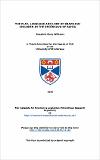Files in this item
The play, language and lore of Brazilian children in the Recôncavo of Bahia
Item metadata
| dc.contributor.advisor | Gifford, Douglas J. | |
| dc.contributor.author | Williams, Rosalind Mary | |
| dc.coverage.spatial | 496 p. | en_US |
| dc.date.accessioned | 2017-06-30T12:07:55Z | |
| dc.date.available | 2017-06-30T12:07:55Z | |
| dc.date.issued | 1978 | |
| dc.identifier | uk.bl.ethos.511489 | |
| dc.identifier.uri | https://hdl.handle.net/10023/11126 | |
| dc.description.abstract | The study records and examines the play, language of Brazilian children in the Recôncavo area of the state of Bahia in Northeast Brazil, using an ethnographic-linguistic approach based on fieldwork, there in 1973-1974. The Recôncavo is a fairly narrow strip of land surrounding the Bay of All the Saints, with its social and economic focus at Salvador, the capital of Bahia state. Play, language and lore are studied in the context of the history and social background of the Recôncavo, one of the earliest Indian-inhabited areas to be settled and colonised by the Portuguese, and one of the most densely African-populated once the Portuguese began to import negro labour to Brazil from Africa, a practice which spanned some three hundred years. Other factors examined are the continuing influences of European immigration at social levels and more recent cultural links with the United States. Children's spontaneous play and imitative behaviour are classified and discussed as far as this is possible but the writer concentrates largely on more organised games detailing and commenting on the procedures and language involved, and, where relevant, indicating parallels and similarities in European and African games, as well as indigenous customs as far as these have been recorded. To facilitate discussion and comparison these into game preliminaries, games of speed and skill, duelling games and tests of strength, games of reflex control, forfeits and guessing, pretending, make-believe and acting games, progressing through infant rhymes and recreations to sung circle games and dramatic dialogues and sketches. Language as popularly employed by children outside their games is then examined and children's riddles and their use of poetic, language are discussed in two subsequent chapters, Popular juvenile lore and the language and practices associated with it are then studied: the writer first details in chronological order a number of recurring popular festivals in which children are particularly involved and then examines occasional customs and beliefs. The terminology employed in games is listed alphabetically in an appendix with explanations in English. There is also an appendix of game, names with chapter references. | en_US |
| dc.language.iso | en | en_US |
| dc.publisher | University of St Andrews | |
| dc.subject.lcc | F2551.W5 | |
| dc.subject.lcsh | Folklore and children--Brazil--Bahia (State) | en |
| dc.subject.lcsh | Play--Brazil--Bahia (State) | en |
| dc.subject.lcsh | Children--Language | en |
| dc.title | The play, language and lore of Brazilian children in the Recôncavo of Bahia | en_US |
| dc.type | Thesis | en_US |
| dc.type.qualificationlevel | Doctoral | en_US |
| dc.type.qualificationname | PhD Doctor of Philosophy | en_US |
| dc.publisher.institution | The University of St Andrews | en_US |
This item appears in the following Collection(s)
Items in the St Andrews Research Repository are protected by copyright, with all rights reserved, unless otherwise indicated.

